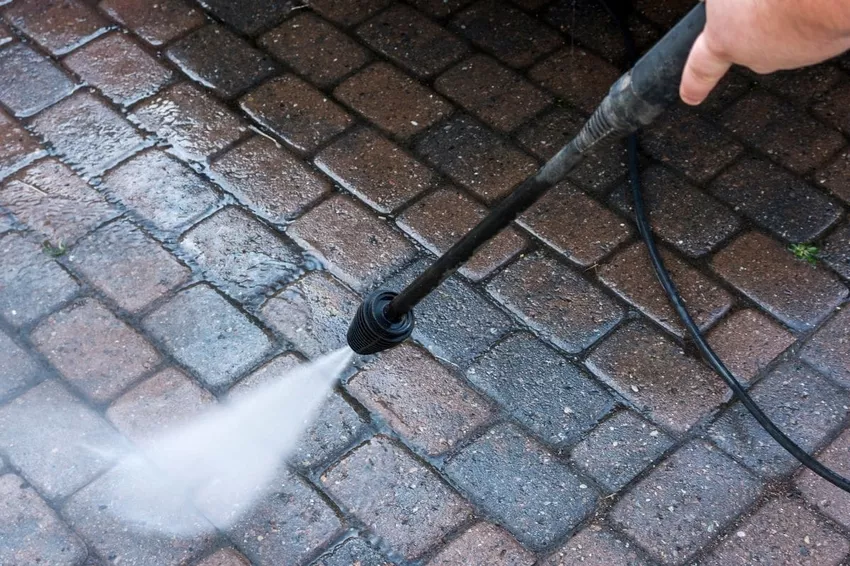- cobblestones and weeds
- Methods for removing weeds
- Prohibited weed killers
- Prevent
- frequently asked Questions

Paving stones fasten paths and squares quickly. Unfortunately, weeds can settle in the joints in particular. This article explains how these disappear again and which weed killers are permitted or forbidden for paving stones.
In a nutshell
- mechanical and thermal methods are possible
- most chemical weed killers are harmful
- even if the ingredients are environmentally friendly, pesticides are not allowed
- only removers for green deposits (moss, algae) are allowed
cobblestones and weeds
A newly paved driveway or a seating area with a natural stone floor are beautiful to look at. Until the first weeds form. Since the joints between the stones are very narrow, it is not easy to remove plants from them. In addition, despite all care, they keep coming back. However, there are effective and legal weed killers that you can use on paving stones.

Methods for removing weeds
There are various ways to remove weeds on and between paving stones effectively and in an environmentally friendly manner.
Sweep
The first green deposits and easily removable weeds can be easily removed with a hard broom. This works best if you sweep the floor thoroughly on a regular basis. The weeds then do not even grow to a size that is difficult to remove.
Notice: The broom is also good for removing leaves or the first snowflakes.

Scratch
With a special joint scraper, weeds can also be removed from very narrow joints. With dandelions, as much of the root as possible should be pulled out of the joint, otherwise the plant will quickly grow back. Moss, on the other hand, hardly has any longer roots. A scraper can also be used to remove it. A wire brush can also be used for heavier green deposits on the stones.
Attention: Wire brushes can damage some stones. They leave scratches on the surface.

flaming device
There are various devices that work with heat. The higher the temperature, the fewer weeds remain. When it is particularly hot, all that remains is ash, which can easily be swept away with a broom. If the temperature is not high enough, the roots can regenerate and the plant will sprout again. The thermal weed killer must then be used again on the paving stones.

Boiling water
Similar to flame burners, boiling water works through the effects of heat. The plant is damaged and dies. The decisive factors here are the temperature and the exposure time. You can also clean the paving stones with hot water and a brush.
high pressure cleaner
If you own a high-pressure cleaner, you can also use it to hose down your paved paths and places. Not all weeds will be removed, but the stones will be clean afterwards. The remaining weeds are then pulled out by hand.

Prohibited weed killers
Although many do not know it, you should not use liquid weed killers that can be bought in stores on paved surfaces such as paving stones. The reason for this is that there is a risk that the agent will end up unchanged in the groundwater or waste water. When applied to grown soil, the agent is broken down through the soil before it gets into the groundwater. Most herbicide ingredients are at least harmful to aquatic organisms, even if they are harmless to insects or domestic animals.
Prohibited Means:
- Weed killer for green areas and gardens
- Means for use in greenhouses or commercial cultivation
- biological herbicides
- self-made resources
- salt
- vinegar

Prevent
To ensure that a paved area stays beautiful for a long time, you should pay attention to a few things when you set it up and prevent weed growth. Many methods are suitable for this, some of which you can also use later. This saves you the hassle of using weed killers for paving stones.
joint sand
Sand makes it difficult for weeds to gain a foothold. However, sand is washed out of the joints over time. That's why you have to renew it every now and then. For this purpose, joint sand is applied to the surface and swept firmly into the joints with a broom.

mortar
Joint mortar can be applied to the surface later, similar to sand, or you can distribute it in the joints when laying the new one. More modern grouts are based on epoxy resin. They are weather-resistant and no cracks form.

foil
Weed fleece or foil are only suitable for a new plant. Alternatively, a layer of compacted gravel at least 25 cm high under the stones can permanently suppress weeds. With both variants you have to work very carefully so that there are no gaps that the weeds could exploit.

fouling
A somewhat unusual method is the deliberate application of small, accessible plants. Larger gaps between natural stones are best suited for this.
Suitable plants:
- Roman carpet chamomile (Chamaemelum nobile)
- Wild thyme (Thymus serpyllum)
- Star Moss (Sagina subulata)
- Carpet Verbena (Phyla nodiflora)
- Dwarf feather pad (Cotula dioica)
 Star moss as decorative growth between paving stones keeps unwanted weeds away.
Star moss as decorative growth between paving stones keeps unwanted weeds away.
frequently asked Questions
Why are there weed killers for paving stones?The fact that private use on paved paths and squares is not permitted is usually only mentioned very briefly in the instructions for use. Weed killers can be used in the garden and on the lawn.
Which weed is the most stubborn?These include, above all, root weeds that spread underground. But seed weeds can also multiply in large numbers as soon as flowering weeds reach seed maturity.
What means are allowed?Stone and paved floor cleaners are allowed, even if they remove moss and algae.